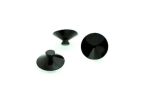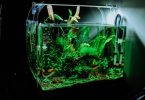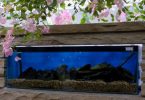Table of Contents
In the world of hobbyists and aquarists as well as in the aquarium community, Chili Rasbora is well known for its appearance.
Chili Rasbora or Mosquito Rasbora (Boraras brigittae) is a specie of ray-finned fish in the genus Boraras belonging to the family, Cyprinidae.
It is a beautiful and tiny nano fish found in small nano tanks where they spend most of their time schooling together in the tank’s mid-water area.
In 1973, a man called Dieter Vogt gave Chili Rasbora its name after his wife, Brigitte and then, it’s alternate name “Mosquito Rasbora” was coined from its natural habitat known to be heavily infested with mosquitoes.
Chili Rasbora are playful fishes, they are characterized by brilliant attractive colours giving the aquarium a stunning aesthetic look.
In addition, they are super peaceful and timid(shy) and so, it helps them get so along with other fishes as well as such as neon tetras, small catfish, dwarf shrimps, minors, gouramis, and celestial pearl danios.
In this article, we will tell you more about the Chili Rasbora, it’s characteristics and every other thing you need to know about taking absolute care of these beautiful creatures.
What does Chili Rasbora look like?
Primarily, Chili Rasboras are slender, with their diminutive size which is about 0.7 to 0.78 inches (2cm) long making them so flexible to be kept. In some cases, some species may reach up to 2.54 cm or one inch.
Their most noticeable feature is their bright coloration. They have an intense red color with dark stripes running along the side of their bodies.
They are also known by the bony rays that support their fins. On their heads, they possess two large eyes.
The males can be differentiated from their female counterparts because the red stripes of the males are more vivid than that of the females.
Also, the males are more slender, more streamlined, and are more brightly colored than females unlike their female counterparts which are larger in size, rounder in shape and have overall duller and more faded looks.
Habitat of Chili Rasboras
The species are found in the swamps in Asia, more specifically in the South Western part of Borneo, Indonesia.
They inhabit freshwater swamps, blackwater streams and pools, this is the perfect breeding area for mosquitoes.
Chili Rasboras can also be found in densely forested areas. These forested areas are sheltered as they are shaded by overhanging trees (vegetation) and shoreline plants.
They appreciate this lush vegetation because the plants help to filter (reduce) light thereby protecting them from exposure to light as well as heat and promoting their color, vibrance and intensity.
Also, floating plants are grown because they will create a good habitat for the planktons and worms, which are a source of food to the Chili Rasbora.
There is also the presence of decayed vegetation and aquatic plants, this helps to give the fish enough cover and protection.
Their natural habitat can also include soft water of pH as low as 4.0 with a slow flow and peat-stained water that is very low in salts and minerals such as chlorine, copper and other chemicals.
This is why it is preferable to use distilled water rather than tap water for your fish. The tap water consists of some traces of chlorine, phosphates and other heavy metals.
The constructed aquariums are expected to be at least as high as 5-gallons (20L).
The Chili which is a schooling fish can swim in the upper as well as the middle portion of the aquarium. They can also venture down to the bottom of the aquarium in their search for food.
Food Requirements of Chili Rasboras
Inasmuch as Chili Rasboras are straightforward eaters; they require varied sources of nutrition. High-quality diets will give them more vibrant and brilliant colours.
Chili Rasboras are omnivores feeding on diets that contain a mixture of vegetables, plant matter and meaty protein
They are micro-predators getting most of their nutritional value from live animals or small prey like mosquito larvae, small daphnia, chopped micro worms, wingless fruit flies, baby brine shrimps, chopped-up blackworms, algae (supplement), vinegar eels, paramecium and other protists (larval stage only), small finely chopped bloodworms and zooplankton floating in the water.
They can also be fed with frozen foods such as: Rotifers, tubifex worms, cyclops and others. But before they are fed with those foods, they need to be chopped and thawed first before putting in the tank water.
They do quite well on a balanced meal of dried fried foods, sinking or slow-sinking micro pellets and flakes.
But because of their diminutive size, they need chopped or powdered foods so that they don’t get choked.
While feeding them, ensure that you don’t overfeed them since they are tiny and they can get sick if they are overfed.
And the more they eat, the more likely they produce needless foods and waste products which would contaminate the water and lead to various diseases.
Lifespan of Chili Rasbora
Generally, the lifespan of Chili Rasboras is greatly affected by the standard and level of care they receive (mainly water conditions).
They can survive up to about six (6) years. But, if all the healthy conditions are met, they can even survive for eight years.
Therefore, the average lifespan of a Chili Rasbora is somewhat between 4 and 8 years. In conclusion to extend the life of your fish, you have to make sure you provide a healthy environment for them.
Chili Rasboras and Common Diseases
Other fish are affected by diseases, so we should expect Chili Rasbora to also be affected by diseases and infections too as they are extremely sensitive to health issues.
There are four main diseases common to Chili Rasbora and they are under listed below:
- Bacterial infection
- Fungal infection
- Columnaris
- Ich
Bacterial Infection
The bacterial infection of the fish is characterized by red ulcers, red streaks, bloating, popped eyes and fuzzy growths.
It is caused by poor or stale foods, stress, poor water quality, and inappropriate water parameters. Generally, you can treat them with a broad spectrum antibacterial.
Fungal Infection
It is characterized by the cottony growths on fins, gills and eyes. It can be treated by quaranting affected fish and then the water should be dosed with antifungal treatment.
Columnaris
This disease is often called false neon tetra disease or cotton mouth disease. Symptoms of columnaris include the following: Popped off and discolored scales, fuzzy patches, lesions on backs and greyish spots.
It is caused by a Gram-negative bacterium, Flavobacterium columnare.
Ich (White spot disease)
This disease is common in fish found in aquariums. The evident symptoms are white spots across the body, fins, and gills of the fish, bloody streaks or redness, rapid breathing and scratching.
This disease is caused by a parasite called Ichthyophthirius multifiliis. Although in most cases, it is caused by stress.
For treatment, the water temperature can be raised to 82°F for 3(three) days, and then a White Spot Disease treatment should be used afterwards.
Chili Rasbora Care Guide
In order to provide a healthy and favorable condition for the fish there are certain requirements and criteria to be fulfilled and they are grouped into 3:
- Tank requirements
- Water conditions
- Temperature range
- pH level
Tank Requirements
The minimum tank size for Chili Rasboras is only 5 gallons which can accommodate about 6 (six) fish but these fish tend to be more active when they are in large groups and when they have more swimming space.
It helps prevent overcrowding, protects your fish from feeling cramped thus, reducing stress.
Regardless of how you wish to keep them, the most important thing is to make sure that the tank is kept clean as the fish are prone to illness and certain health issues because of their small size which makes them sensitive to changes in water conditions such as dirtiness as well as stress.
So, cleaning the tank always is of great paramount importance.
In addition, the tank must have a tight lid as it would help to protect the aquarium from dust and other contaminants.
And even though they are not known for jumping, they may leap out of the tank if the lid is untight. Cramming should be also avoided as it can affect the fish.
Furthermore, ensure that there is dim light setting in the tank by using the floating plants to reduce (limit) the light entering the tank and provide adequate shelter for the fish.
The lower (dimmer) the light, the happier your fish will be. Java moss and Najas grass make excellent low light carpets for Chilis.
Also, they thrive well in water with dark substrate because it brightens their colors the most and improves their health.
Water Condition
Chili Rasboras are easy fish to care for and maintain provided you grow them in the correct (right) water conditions, recreating their natural habitat in your aquarium.
They require a tank with a weak filtration system and slow flow of water because they are not strong enough to swim against strong currents.
But if there is an existing current, it can be broken up by adding branches, brava fern, logs, driftwood, floating plants and many more.
It is important to make sure that there are no traces of heavy metals like copper, and minerals like chlorine and salts in the water as they can impair the health of the fish and affect the aquarium generally. In addition to good water quality, they also prefer water that is both acidic and soft.
Using reversed osmosis or distilled water is recommended as it is relatively inexpensive, very soft, and filtered of impurities and heavy metals.
In other words, they do not have high mineral content like the tap water. But in cases where the use of tap water is unavoidable, the tap water can be diluted using distilled water or reverse osmosis (RO).
After blending, the tap water should be passed through simple water treatment tests to make sure the minerals as well as chemicals have been gotten rid of by determining GH, KH, and PH.
This will help the aquarist determine how much more RO or distilled water to add to the tap water to create the proper conditions.
Ornaments with no sharp edges or toxic colors can also be used to decorate the tank. It can be pebbles, ruins, caves, statues, rocks, or stones.
Temperature Range
It can thrive in water temperatures between 75 – 78° F.
PH level
The Chili Rasbora can thrive well within the pH range of 4.0 to 7.0. This pH is beneficial for the health of the fish as well as reducing the pathogenic content of the water.
It is also recommended that dry pesticide-free natural remedies like peat moss or peat pellets, catappa leaves, oak leaves, almond leaves and others that can condition the water and reduce pH after decomposing.
This decomposition is characterized by a light tint in the water caused by the release of tannins. Tannins are organic chemical compounds that help to bring out that vibrant color of the fish.
On the other hand, it is worthy to note that catappa leaves can reduce the risk of the fish being infected by fungal and bacterial infections such as columnaris etc.
Chili Rasbora Tankmates
Getting to find perfect tankmates for Chili Rasbora can be quite easy and tedious at the same time because of their miniscule size. They are fun to watch when they are schooling together with peaceful tankmates.
These tankmates are below 2 inches and anything greater than 2 inches is likely to startle them and cause stress.
The best tankmates for them are other Chili Rasbora. Other excellent tankmates for the fish include the following:
-
Harlequin rasbora
It has a distinctive small size and is similar in colour to that of the Chili Rasbora.
-
Neon petra
They are almost as small and docile (gentle) as the Chili Rasbora. They have similar behavior to that of the Chili Rasbora.
-
Pygmy cory
They are small as well as active fish and they can thrive well in the bottom of a nano tank.
-
Sparkling Gouramis (Pygmy Gouramis)
They have a small size of 4 cm (1½ inches) as well as a non-aggressive fish.
-
Cory catfish
These fish can otherwise be called Cory cats, Corydoras catfish, and Cory fish. Their lengths range from about 1 inch to over 4 inches,
-
Celestial Pearl Danio (Galaxy rasbora)
It measures just 2 to 2.5 cm normal length.
- Wood shrimp
- Amano shrimp
- Bettas
- Endler’s Livebearers
- Cherry shrimp
- Dwarf suckers
- Micro glassfish
- Guppies
- Few Nerite snails
- Small Killifish
- Dwarf Pencilfish
Bad (poor) tankmates
A good aquarist or hobbyist should not keep these fish with large species and aggressive attributes with them because they will compete with them for their food and then feed on them as well. Some of the bad tankmates of the Chili Rasbora are:
- Cichlids
- Clown loaches
- Most Barbs
- Medium to Large Catfish
- Crayfish
- Giant Danios
- Angelfish
- Larger Gouramis, and other medium sized community fish
Facts about Chili Rasbora (Boraras brigittae)
- There Chili Rasbora belongs to the Boraras genus. Other species of Boraras include: Boraras maculatus, Boraras merah, Boraras urophthalmoides, Boraras micros, and Boraras naevus.
- Although they are very tiny nano fish, they can still be noticed because of their bright coloration.
- Cherry shrimp is also a good tankmate for Chili Rasbora.
- During their courtship period, it is very important to feed them more often so as to get them into both mating and breeding conditions.
- They are classified as a micro predator and feed on microscopic live prey.
Conclusion
Chili Rasbora care is relatively easy and straightforward so this makes it easier to keep them since it doesn’t require a lot of experience and expertise.
But much attention has to be paid to the water conditions and their environment if you want them to survive as they can be easily affected by poor water quality (condition) and stress.
These fishes prefer an aquarium setting that is similar to their natural habitat.







